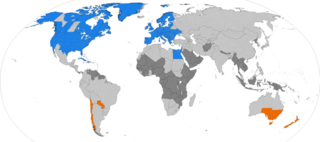
Daylight saving time (DST), also known as daylight savings time or daylight time, and summer time, is the practice of advancing clocks during warmer months so that darkness falls at a later clock time. The typical implementation of DST is to set clocks forward by one hour in the spring and set clocks back by one hour in autumn to return to standard time. As a result, there is one 23-hour day in late winter or early spring and one 25-hour day in the autumn.
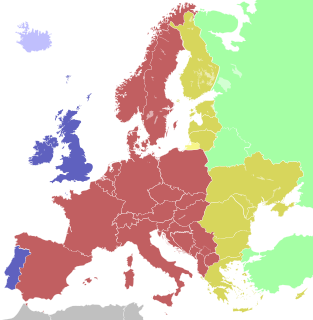
Western European Summer Time is a summer daylight saving time scheme, 1 hour ahead of Greenwich Mean Time and Coordinated Universal Time. It is used in:
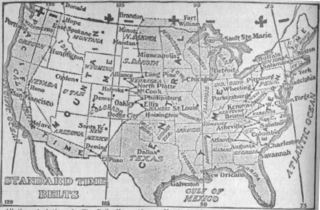
The history of standard time in the United States began November 18, 1883, when United States and Canadian railroads instituted standard time in time zones. Before then, time of day was a local matter, and most cities and towns used some form of local solar time, maintained by some well-known clock. The new standard time system was not immediately embraced by all.

The Uniform Time Act of 1966, Pub.L. 89–387, 80 Stat. 107, enacted April 13, 1966, was a Law of the United States to "promote the adoption and observance of uniform time within the standard time zones" prescribed by the Standard Time Act of 1918. Its intended effect was to simplify the official pattern of where and when daylight saving time (DST) is applied within the U.S. Prior to this law, each state had its own scheme for when DST would begin and end, and in some cases, which parts of the state should use it.

Australia uses three main time zones: Australian Western Standard Time, Australian Central Standard Time, and Australian Eastern Standard Time. Time is regulated by the individual state governments, some of which observe daylight saving time (DST). Australia's external territories observe different time zones.
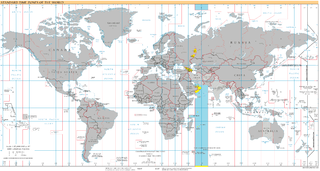
UTC+04:00 is an identifier for a time offset from UTC of +04:00. In ISO 8601 the associated time would be written as 2019-02-07T23:28:34+04:00. This time is used in:

Time in Brazil is calculated using standard time, and the country is divided into four standard time zones: UTC−02:00, UTC−03:00, UTC−04:00 and UTC−05:00.
Time in Chile is divided into three time zones. Most of Continental Chile uses the time offset UTC−04:00 in winter time and UTC−03:00 in summer time, while the Magallanes and Chilean Antarctica region uses the time offset UTC-03:00 the whole year. Additionally, Easter Island uses the time offset UTC−06:00 in winter time and UTC−05:00 in summer time

The time zone in Germany is Central European Time and Central European Summer Time. Daylight saving time is observed from the last Sunday in March to the last Sunday in October. The doubled hour during the switch back to standard time is named 2A and 2B.

Mexico uses four main time zones since February 2015. Most of the country observes Daylight Saving Time (DST).
- Zona Sureste covers the state of Quintana Roo is UTC-05:00 year round. It is the equivalent of U.S. Eastern Standard Time.
- Zona Centro covers the eastern three-fourths of Mexico, including Mexico City, Guadalajara, and Monterrey. For most of the year, it is the equivalent of U.S. Central Time.
- Zona Pacífico covers the states of Baja California Sur, Chihuahua, Nayarit, Sinaloa, and Sonora. For most of the year, it is the equivalent of U.S. Mountain Time. The state of Sonora, like the adjacent U.S. state of Arizona, does not observe DST.
- Zona Noroeste covers the state of Baja California. It is identical to U.S. Pacific Time, including the DST schedule.
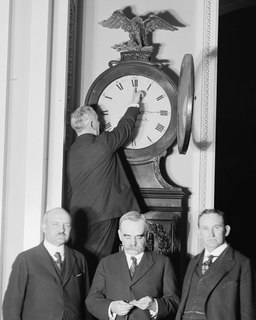
Daylight saving time in the United States is the practice of setting the clock forward by one hour when there is longer daylight during the day, so that evenings have more daylight and mornings have less. Most areas of the United States and Canada observe daylight saving time (DST), the exceptions being Arizona, Hawaii, and the overseas territories of American Samoa, Guam, the Northern Mariana Islands, Puerto Rico, and the United States Virgin Islands. The Uniform Time Act of 1966 established the system of uniform daylight saving time throughout the US.

Each state and territory of Australia determines whether or not to use daylight saving time (DST). However, during World War I and World War II all states and territories had daylight saving by federal law, under the defence power in section 51 of the constitution. In 1968, Tasmania was the first state since the war to adopt daylight saving. In 1971, New South Wales, Victoria, Queensland, South Australia, and the Australian Capital Territory also adopted daylight saving, while Western Australia and the Northern Territory did not. Queensland abandoned daylight saving in 1972. Queensland and Western Australia have observed daylight saving over the past 40 years from time to time on a trial basis.
Brazil observed daylight saving time (DST) in the years of 1931–1933, 1949–1953, 1963–1968 and 1985–2019. Initially it applied to the whole country, but from 1988 it applied only to part of the country, usually the southern regions, where DST is more useful due to a larger seasonal variation in daylight duration.
Daylight saving time in the Americas is the arrangement in the Americas by which clocks are advanced by one hour in spring and moved back in autumn, to make the most of seasonal daylight. The practice is widespread in North America, with most of Canada, Mexico, and the United States of America participating, but much less so in South America.

As of 2018, daylight saving time (DST) is permanently observed in Morocco. Previously, time was advanced to UTC+01:00 at 02:00 on the last Sunday of March, and reverted to UTC±00:00, defined as Greenwich Mean Time locally, at 03:00 on the last Sunday of October. This practise was continued through October 2018, after which clocks were permanently advanced. An exception was made during the month of Ramadan during which clocks reverted to UTC+00:00.

As of 2017, daylight saving time is used in the following Asian countries:

The only African country and regions that use daylight saving time are:
Parts of Australia, New Zealand, Fiji and Samoa are areas of Oceania that currently observe daylight saving time (DST).

Portugal has two time zones and observes daylight saving time. Continental Portugal and Madeira use UTC+00:00, while the Azores use UTC–01:00. Daylight saving time is observed nationwide from the last Sunday in March to the last Sunday in October, so that every year, continental Portugal and Madeira temporarily use UTC+01:00, and the Azores temporarily use UTC+00:00.

In Romania, the standard time is Eastern European Time. Daylight saving time, which moves one hour ahead to UTC+03:00 is observed from the last Sunday in March to the last Sunday in October.











